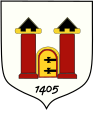
Alternate names: Przedbórz [Pol], Pshedbuzh, Пшедбуж [Rus], פשדבוז [Yid], Preshedborz, Pshedbosh, Pshedbozh, Pshedburz. 51°05' N, 19°53' E, 24 miles WSW of Końskie (Kinsk), 24 miles SSE of Piotrków Trybunalski, 19 miles E of Radomsko (Novo-Radomsk). Yizkors: Przedborz -- 33 shanim le-hurbana (Tel Aviv, 1977) and Pinkas ha-kehilot; entsiklopediya shel ha-yishuvim le-min hivasdam ve-ad le-aher shoat milhemet ha-olam ha-sheniya: Poland vol. 1: The communities of Lodz and its region (Jerusalem, 1976). 1900 Jewish population: 4,089. Słownik Geograficzny Królestwa Polskiego (1880-1902), IX, pp. 133-135: "Przedbórz" #1. Gmina Przedbórz is an urban-rural administrative district in Radomsko powiat, Łódź Voivodeship in central Poland with its seat is the town of Przedbórz on the Pilica River, 31 km (19 mi) E of Radomsko and 83 km (52 mi) S of the regional capital Łódź. The gmina 2006 total population is 7,595 with 3,758 in the town. Apart from the town of Przedbórz, Gmina Przedbórz contains the villages and settlements of Borowa, Brzostek, Chałupki, Faliszew, Gaj, Góry Mokre, Góry Suche, Grobla, Jabłonna, Józefów, Kajetanów, Kaleń, Miejskie Pola, Mojżeszów, Nosalewice, Piskorzeniec, Policzko, Przyłanki, Stara Wieś, Stary Józefów, Taras, Wojciechów, Wola Przedborska, Wygwizdów, Wymysłów, Zagacie, Żeleźnica and Zuzowy. cemetery photos. Jewish history. Przedbórz's Jewish community dates from the 12th century. The city's location on major trade routes from Ruthenia, Little Poland, and Silesia attracted Jewish settlement. In 1594, the kahal was legalized with the first synagogue and cemetery created at that time. Increasing Jewish settlement led to protests by the city's other residents so that in 1595, King Sigismund III Vasa prohibited Jews from owning homes in the city and barred the Polish population from selling Jews real estate punishable by a severe fine. Rescinded by King Ladislaus IV after the city was destroyed by fire in 1638, Jews settling in the city helped rebuild and repopulate the city and hold the weekly market and annual fair. Przedbórz was granted the privilege to organize six fairs a year. Three of them were so large that they lasted more than a week. Merchants traded included wood, cattle and agricultural products by merchants like Pawel Abramowicz, Jakub Markus, Icek Fraimowicz, Lewek Lejzerowicz, and Izrael from Przedbórz, a wholesale merchant. By the 1820s, the Jewish population was two-thirds of the town's expanding population. During the second half of the 19th century, factories of all sorts sprung up. In 1939, five prayer houses and the synagogue belonged to the Jewish community who were represented by more than half of This email address is being protected from spambots. You need JavaScript enabled to view it.'s city council members. Destroyed during the September campaign of WWII, the wooden synagogue was burned. In January 1940, the occupying Germans created a ghetto for over 4,500 Jews. In October 1942, that ghetto was liquidated with Jews first transferred to the Radomsko ghetto and to Treblinka. The nine survivors eturned to Przedbórz in 1945. Around New Year's 1946, they were murdered in the Radoszycki Forest by right-wing underground members. ShtetLink. photos. photos. [June 2009]
US Commission No. POCE000035
Przedborz is located in Piotrkow at 51º05 19º53, 33 km. from Radomsko, 48 km. from Piotrkow. The cemetery is located at Ogrodowa Str. Present town population is 1,000-5,000 with no Jews.
- Town officials: Urzad Miasta i Gminy, ul. Mostowa; tel. 1-22-42.
- Local: Z. Blaszczyk, region Konserwator Zabytkow, 97-300 Piotrkow tryb. ul. Czerwonej Armii 29; tel. 56-46.
The earliest known Jewish community was 1594. The Orthodox Jewish population was 3749 (in 1921), 63.7%. The isolated suburban site has no sign or marker. Reached by turning directly off a public road, access is open to all. No wall or fence or gate surrounds the cemetery. 100-500 stones date from 1709-20th century. The sandstone finely smoothed and inscribed stones or flat stones with carved relief decoration have Hebrew inscriptions. The cemetery contains no known mass graves or structures. The municipality owns site. The cemetery boundaries have not changed since 1939. Rarely, local residents visit. The cemetery was vandalized during World War II. No maintenance.
Jan Pawet Woronczak, Sandomierska 21m.1; 02-567 Warszawa, tel. 49-54-62 completed survey on 6 Sep 1991. The site was not visited. No interviews.
Jeff Donsky, Toronto, Canada visited here and has photographs. [September 1998]
